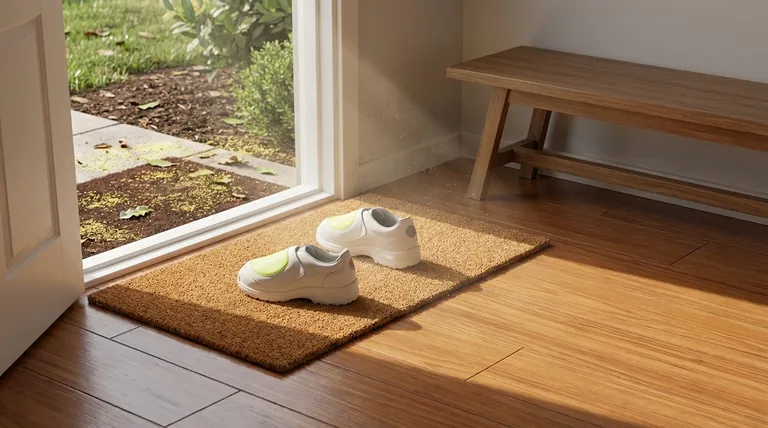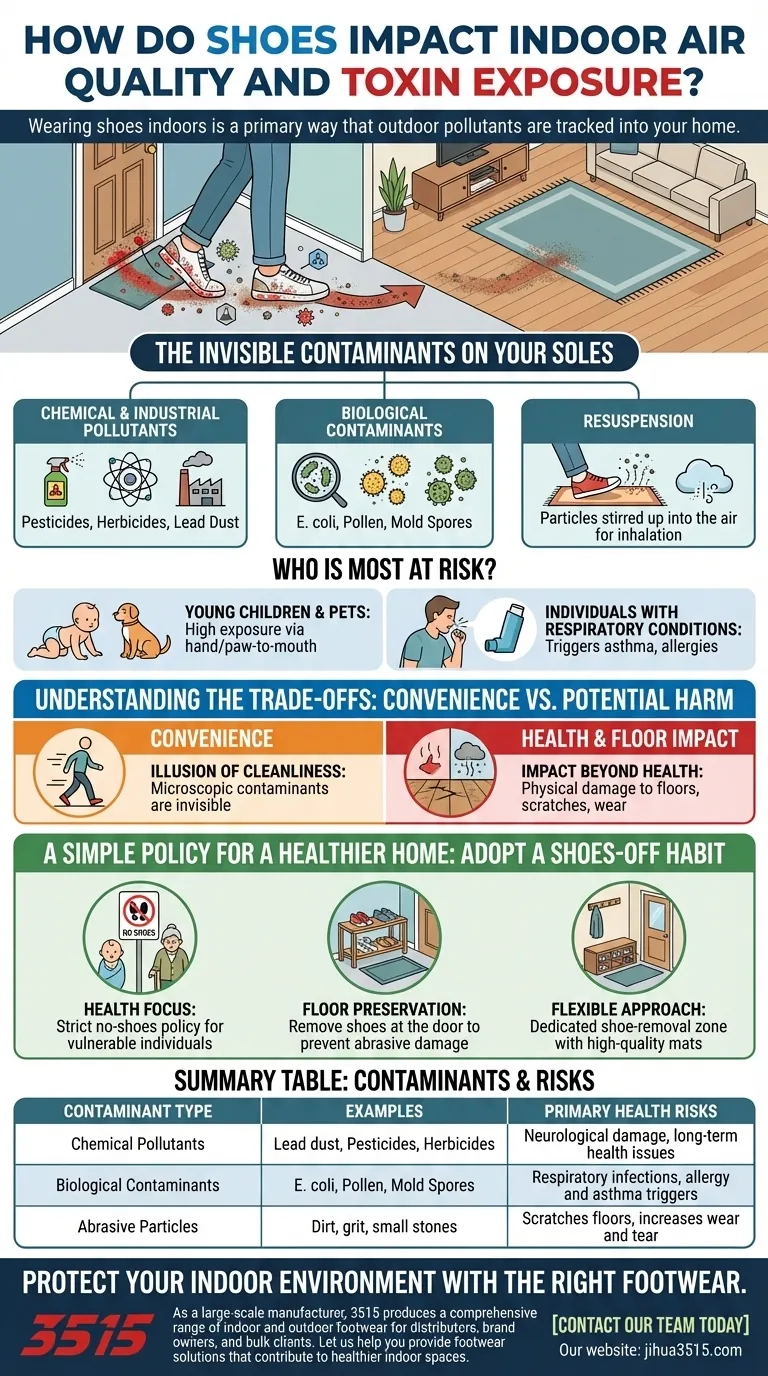Wearing shoes indoors is a primary way that outdoor pollutants are tracked into your home. The soles of your shoes act as carriers for a wide range of contaminants, including lead dust, pesticides from lawns, pollen, and various bacteria. These substances then settle into your carpets and floors, directly impacting your indoor air quality and creating a source of long-term exposure.
The core issue is not about visible dirt, but the invisible contaminants your shoes collect. Implementing a simple shoes-off policy at the door is the single most effective way to reduce the concentration of these harmful substances in your living environment.

The Invisible Contaminants on Your Soles
The bottom of your shoes provides a direct link between the outdoor environment and your indoor space. This transfer mechanism introduces several categories of unwanted materials.
Chemical and Industrial Pollutants
Your shoes can pick up lawn care chemicals, pesticides, and herbicides from treated grass and soil. They can also accumulate lead dust, which is still present in the soil near older homes or busy roads, and carry it inside where it can become part of the household dust.
Biological Contaminants
Studies have found that bacteria, including E. coli, are commonly found on the exterior of shoes. In addition to bacteria, shoes readily track in pollen, mold spores, and other allergens that can become airborne and trigger respiratory issues.
The Problem of Resuspension
Once these contaminants are on your floor, they don't just stay there. The simple act of walking around stirs these fine particles up, a process known as resuspension, sending them back into the air where they can be inhaled.
Who Is Most at Risk?
While these contaminants affect everyone, certain individuals are significantly more vulnerable to the health risks associated with them.
Young Children and Pets
Infants, toddlers, and pets spend most of their time on or near the floor. They are highly susceptible to exposure through both inhalation and direct ingestion from hand-to-mouth (or paw-to-mouth) contact with contaminated surfaces.
Individuals with Respiratory Conditions
For people with asthma, allergies, or other chronic respiratory conditions, the introduction of dust, pollen, and chemical particulates can act as a trigger, worsening their symptoms and overall health.
Understanding the Trade-offs
The decision to wear shoes inside is often one of convenience versus potential harm. The primary trade-off is sacrificing a minor convenience for a significant reduction in indoor pollution.
The Illusion of Cleanliness
Floors that look clean can still harbor microscopic contaminants. Relying on visual cues is ineffective, as the most concerning pollutants like lead dust and pesticide residues are invisible to the naked eye.
Impact Beyond Health
Beyond air quality, shoes cause direct physical damage. Grit and small stones embedded in shoe treads act like sandpaper, scratching hardwood, scuffing tile, and grinding down carpet fibers, leading to premature wear and tear on your flooring.
A Simple Policy for a Healthier Home
Creating a healthier indoor environment doesn't require complex solutions. A clear and consistent policy on footwear is a powerful first step.
- If your primary focus is the health of vulnerable individuals: A strict no-shoes policy is the most critical change you can make, especially if you have young children or family members with respiratory issues.
- If your primary focus is preserving your floors and reducing cleaning: Removing shoes at the door is the single best way to prevent abrasive damage and minimize the amount of dirt tracked throughout the house.
- If you require a more flexible approach: Establish a dedicated shoe-removal zone inside your main entryway with high-quality doormats and a shoe rack to contain contaminants in one area.
Adopting a shoes-off habit is one of the simplest and most effective changes you can make for a cleaner and safer indoor environment.
Summary Table:
| Contaminant Type | Examples | Primary Health Risks |
|---|---|---|
| Chemical Pollutants | Lead dust, pesticides, herbicides | Neurological damage, long-term health issues |
| Biological Contaminants | E. coli, pollen, mold spores | Respiratory infections, allergy and asthma triggers |
| Abrasive Particles | Dirt, grit, small stones | Scratches floors, increases wear and tear |
Protect your indoor environment with the right footwear.
As a large-scale manufacturer, 3515 produces a comprehensive range of indoor and outdoor footwear for distributors, brand owners, and bulk clients. Whether you need comfortable, dedicated indoor slippers for a household policy or durable outdoor boots designed to minimize contaminant pickup, we have the production capabilities to meet your needs.
Let us help you provide footwear solutions that contribute to healthier indoor spaces. Contact our team today to discuss your requirements.
Visual Guide

Related Products
- Customizable Slip-On Safety Shoes Direct from the Factory for Wholesale
- Wholesale Customizable Suede Safety Boots - Puncture-Proof with Velcro Closure
- Wholesale Anti-Smash & Puncture-Proof Safety Shoes Custom Manufacturing for Brands
- Wholesale Mesh Steel Toe Safety Shoes with Dial Closure Factory Production
- Athletic Safety Shoes with Dial Closure & Steel Toe for Wholesale & Custom Manufacturing
People Also Ask
- How does toe box design differ between men's and women's work boots? Fit for a Woman's Foot Anatomy
- What cultural and environmental considerations are tied to wearing shoes indoors? Balance Hygiene, Tradition, and Foot Health
- What are the cultural perspectives on wearing shoes in the house? A Guide to Home Etiquette & Hygiene
- What are the potential consequences of wearing improperly designed work boots? Avoid Injury & Boost Safety
- Why is proper fit important in work boots? Ensure Safety, Comfort & Long-Term Health



















